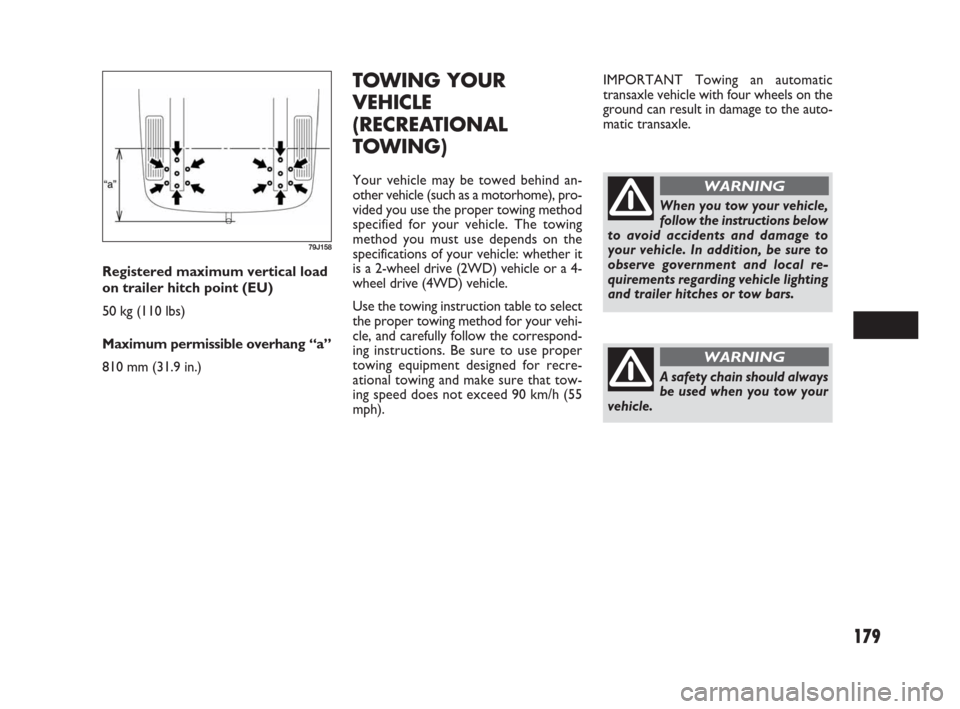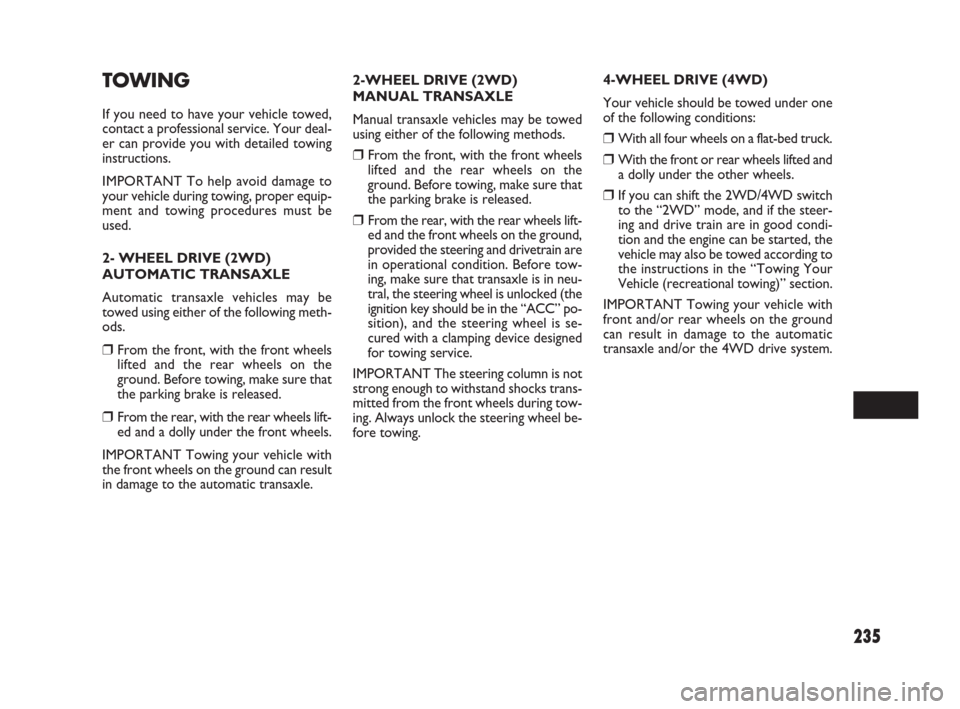Page 180 of 270

179
TOWING YOUR
VEHICLE
(RECREATIONAL
TOWING)
Your vehicle may be towed behind an-
other vehicle (such as a motorhome), pro-
vided you use the proper towing method
specified for your vehicle. The towing
method you must use depends on the
specifications of your vehicle: whether it
is a 2-wheel drive (2WD) vehicle or a 4-
wheel drive (4WD) vehicle.
Use the towing instruction table to select
the proper towing method for your vehi-
cle, and carefully follow the correspond-
ing instructions. Be sure to use proper
towing equipment designed for recre-
ational towing and make sure that tow-
ing speed does not exceed 90 km/h (55
mph). Registered maximum vertical load
on trailer hitch point (EU)
50 kg (110 lbs)
Maximum permissible overhang “a”
810 mm (31.9 in.)
When you tow your vehicle,
follow the instructions below
to avoid accidents and damage to
your vehicle. In addition, be sure to
observe government and local re-
quirements regarding vehicle lighting
and trailer hitches or tow bars.
WARNING
A safety chain should always
be used when you tow your
vehicle.
WARNING
79J158
IMPORTANT Towing an automatic
transaxle vehicle with four wheels on the
ground can result in damage to the auto-
matic transaxle.
173-182 SEDICI LUM FL GB 1E 19-06-2009 10:49 Pagina 179
Page 181 of 270
180
A: 2WD (EXCEPT 2WD MODE
OF 4WD) VEHICLES WITH
MANUAL TRANSAXLE OR
AUTOMATIC TRANSAXLE
❒Secure the front wheels on a towing
dolly according to the instructions pro-
vided by the dolly manufacturer.
❒Release the parking brake.
54G212
TOWING METHOD A
FROM THE FRONT:
FRONT WHEELS ON A DOLLY
AND REAR WHEELS ON THE GROUND
TOWING INSTRUCTION TABLE
DRIVE TRAIN
2WD
4WD
including
2WD modeTOWING
METHOD
A
A B
B TRANSAXLE
A/T
M/T
M/T
54G641
173-182 SEDICI LUM FL GB 1E 19-06-2009 10:49 Pagina 180
Page 182 of 270
181
79J130
TOWING METHOD B
FROM THE FRONT:
FOUR WHEELS ON THE GROUND
B: 2WD (EXCEPT 2WD MODE
OF 4WD) VEHICLES WITH
MANUAL TRANSAXLE
❒Shift the manual transaxle lever into
neutral.
❒Turn the ignition key to the “ACC” po-
sition to unlock the steering wheel.
❒Release the parking brake.
IMPORTANT The steering column is not
strong enough to withstand shocks trans-
mitted from the front wheels during tow-
ing. Always unlock the steering wheel be-
fore towing.
173-182 SEDICI LUM FL GB 1E 19-06-2009 10:49 Pagina 181
Page 183 of 270
182
B: 4WD (INCLUDING 2WD
MODE OF 4WD) VEHICLES
WITH MANUAL TRANSAXLE
IMPORTANT Do not tow the 4WD vehi-
cle with either front wheels or rear wheels
directly on the ground (and the transaxle
in neutral). If you do, the transaxle will be
damaged fatally.
❒Shift the 2WD/4WD switch to the
“2WD” mode.
❒Shift the manual transaxle lever into
neutral.
❒Turn the ignition key to the “ACC”
position to unlock the steering wheel.
❒Release the parking brake.
IMPORTANT The steering column is
not strong enough to withstand shocks
transmitted from the front wheels dur-
ing towing. Always unlock the steering
wheel before towing.
79J175
79J176
173-182 SEDICI LUM FL GB 1E 19-06-2009 10:49 Pagina 182
Page 191 of 270

MAINTENANCE RECOMMENDED UNDER SEVERE DRIVING CONDITIONS
If the vehicle is usually used under the conditions corresponding to any severe condition code given below, it is recommended that
applicable maintenance operation be performed at the particular interval as given in the chart below.
190
G----
HTrailer towing (if admitted)
Maintenance Operation
IInspect and correct or replace if necessary
RReplace or Change
NOTE 4WD: 4-wheel drive Severe condition code
ARepeated short trips
BDriving on rough and/or muddy roads
CDriving on dusty roads
DDriving in extremely cold weather and/or salted roads
ERepeated short trips in extremely cold weather
FLeaded fuel use
Severe Condition Code
B C D
A D
A C D E F H
A C D E H
A B C E F H
C
B E H
B C D H
B D E H
B E H
C D
Maintenance Interval
Every 15,000 km (9,000 miles) or 12 months
Every 45,000 km (27,000 miles) or 36 months
Every 36 months
Every 7,500 km (4,500 miles) or 6 months
Every 7,500 km (4,500 miles) or 6 months
Every 30,000 km (18,000 miles) or 24 months
Every 10,000 km (6,000 miles) or 8 months
Every 2,500 km (1,500 miles)
Every 30,000 km (18,000 miles) or 24 months
Every 30,000 km (18,000 miles) or 24 months
Every 15,000 km (9,000 miles) or 12 months
Every 15,000 km (9,000 miles) or 12 months
First time only:
15,000 km (9,000 miles) or 12 months
Second time and after:
Every 30,000 km (18,000 miles) or 24 months
reckoning from 0 km (0 mile) or 0 month
Every 15,000 km (9,000 miles) or 12 months
Every 45,000 km (27,000 miles) or 36 months Maintenance
Engine accessory drive belt (V-rib belt)
Camshaft timing belt (Diesel engine)
Engine oil and oil filter (Gasoline engine)
Engine oil and oil filter (Diesel engine)
Spark plugs
Air cleaner filter element
(Inspect or replace more frequently if necessary)
Automatic transaxle fluid change
Wheel bearings
Drive axle boots/Propeller shaft (4WD)
Manual transaxle oil/Transfer oil (4WD)
Differential oil (4WD)
Air conditioner filter element (for versions/markets, where provided)
(Clean more frequently if the air flow from the air conditioner
decreases)Maintenance
Operation
I
R
R
R
R
R
R
I
R
R
I
I
R
I
R Iridium plug
(Highly recommended)
Nickel plug
(Standard type)
183-230 SEDICI LUM FL GB 1E 19-06-2009 11:00 Pagina 190
Page 232 of 270
231
E E
M M
E E
R R
G G
E E
N N
C C
Y Y
S S
E E
R R
V V
I I
C C
E E
60G411
JACKING INSTRUCTIONS................................................ 232
JUMP STARTING INSTRUCTIONS ................................. 233
TOWING................................................................................ 235
IF THE STARTER DOES NOT OPERATE ...................... 236
IF THE ENGINE IS FLOODED.......................................... 236
IF THE ENGINE OVERHEATS........................................... 236
IF YOU CAN NOT SHIFT AUTOMATIC TRANSAXLE
GEARSHIFT LEVER OUT OF “P” (PARK)...................... 238
9
231-238 SEDICI LUM FL GB 1E 19-06-2009 11:06 Pagina 231
Page 235 of 270

234
❒Turn off all vehicle accessories, except
those necessary for safety reasons (for
example, headlights or hazard lights).
❒Make jump lead connections as follows:
– Connect one end of the first jump
lead to the positive (+) terminal of
the flat battery (1).
– Connect the other end to the posi-
tive (+) terminal of the booster bat-
tery (2).
– Connect one end of the second jump
lead to the negative (–) terminal of
the booster battery (2).
– Make the final connection to an un-
painted, heavy metal part (i. e. engine
hook (3)) of the engine of the vehi-
cle with the flat battery (1).
❒If the booster battery you are using is
fitted to another vehicle, start the en-
gine of the vehicle with the booster bat-
tery. Run the engine at moderate
speed.
❒Start the engine of the vehicle with the
flat battery.
❒Remove the jump leads in the exact re-
verse order in which you connected
them. IMPORTANT Your vehicle should not be
started by pushing or towing. This start-
ing method could result in permanent
damage to the catalytic converter. Use
jump leads to start a vehicle with a weak
or flat battery.
WHEN JUMP STARTING YOUR
VEHICLE, USE THE
FOLLOWING PROCEDURE
❒Use only a 12 volt battery to jump start
your vehicle. Position the good 12 V
battery close to your vehicle so that the
jump leads will reach both batteries.
When using a battery installed on an-
other vehicle, DO NOT LET THE VE-
HICLES TOUCH. Set the parking
brakes fully on both vehicles.
– To avoid harm to yourself
or damage to your vehicle or
battery, follow the jump starting in-
structions below precisely and in order.
If you are in doubt, call for qualified
road service.
WARNING
(1)
(3)
(2)
54G079
Never connect the jump lead
directly to the negative (–)
terminal of the discharged battery, or
an explosion may occur.
WARNING
231-238 SEDICI LUM FL GB 1E 19-06-2009 11:06 Pagina 234
Page 236 of 270

235
2-WHEEL DRIVE (2WD)
MANUAL TRANSAXLE
Manual transaxle vehicles may be towed
using either of the following methods.
❒From the front, with the front wheels
lifted and the rear wheels on the
ground. Before towing, make sure that
the parking brake is released.
❒From the rear, with the rear wheels lift-
ed and the front wheels on the ground,
provided the steering and drivetrain are
in operational condition. Before tow-
ing, make sure that transaxle is in neu-
tral, the steering wheel is unlocked (the
ignition key should be in the “ACC” po-
sition), and the steering wheel is se-
cured with a clamping device designed
for towing service.
IMPORTANT The steering column is not
strong enough to withstand shocks trans-
mitted from the front wheels during tow-
ing. Always unlock the steering wheel be-
fore towing.
TOWING
If you need to have your vehicle towed,
contact a professional service. Your deal-
er can provide you with detailed towing
instructions.
IMPORTANT To help avoid damage to
your vehicle during towing, proper equip-
ment and towing procedures must be
used.
2- WHEEL DRIVE (2WD)
AUTOMATIC TRANSAXLE
Automatic transaxle vehicles may be
towed using either of the following meth-
ods.
❒From the front, with the front wheels
lifted and the rear wheels on the
ground. Before towing, make sure that
the parking brake is released.
❒From the rear, with the rear wheels lift-
ed and a dolly under the front wheels.
IMPORTANT Towing your vehicle with
the front wheels on the ground can result
in damage to the automatic transaxle.4-WHEEL DRIVE (4WD)
Your vehicle should be towed under one
of the following conditions:
❒With all four wheels on a flat-bed truck.
❒With the front or rear wheels lifted and
a dolly under the other wheels.
❒If you can shift the 2WD/4WD switch
to the “2WD” mode, and if the steer-
ing and drive train are in good condi-
tion and the engine can be started, the
vehicle may also be towed according to
the instructions in the “Towing Your
Vehicle (recreational towing)” section.
IMPORTANT Towing your vehicle with
front and/or rear wheels on the ground
can result in damage to the automatic
transaxle and/or the 4WD drive system.
231-238 SEDICI LUM FL GB 1E 19-06-2009 11:06 Pagina 235